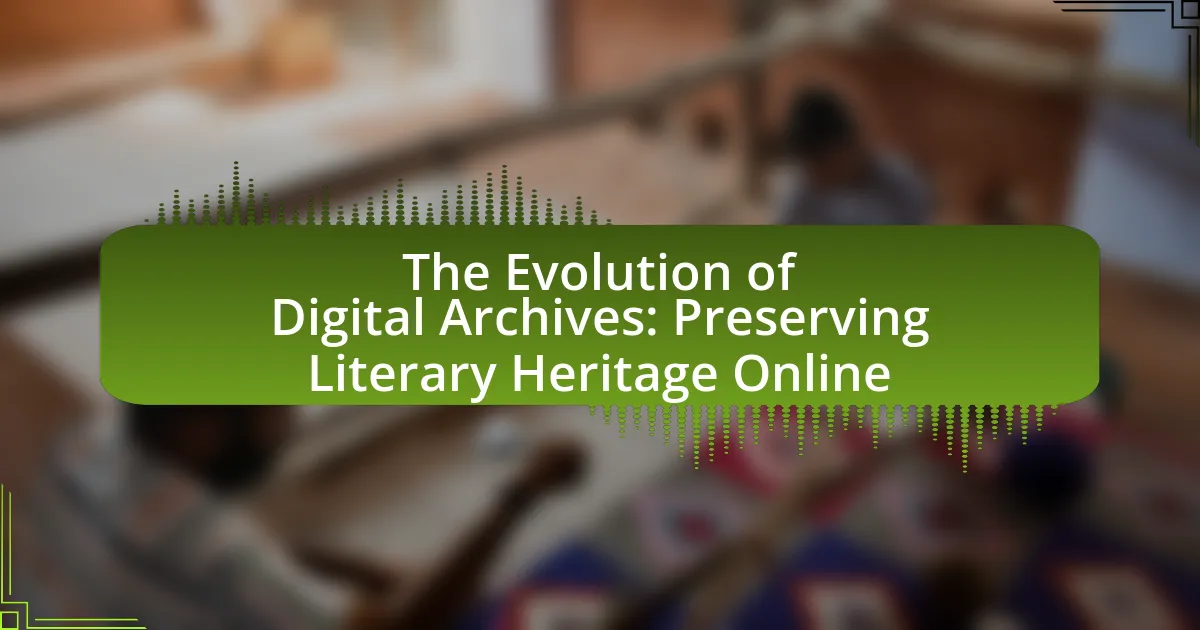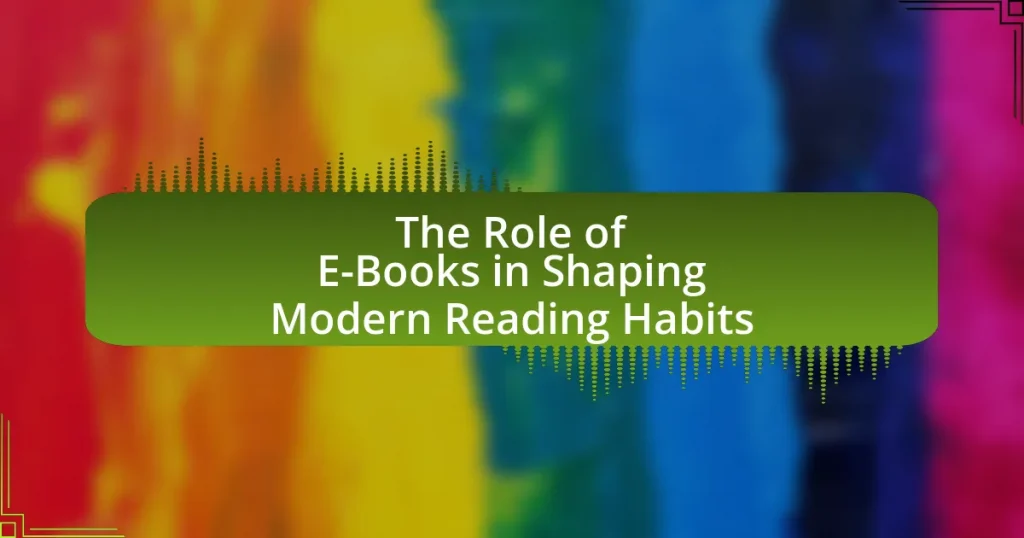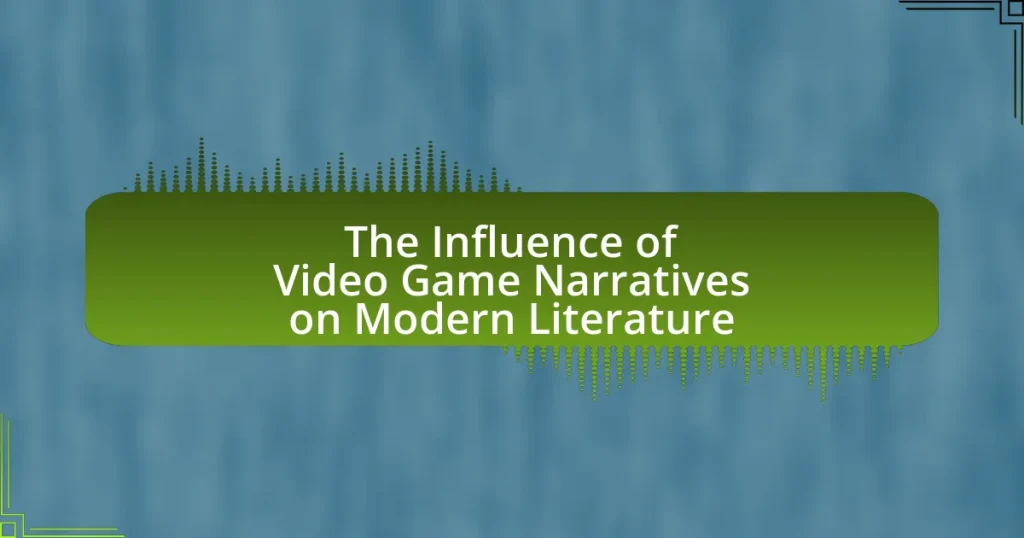Digital archives are organized collections of digitized materials that play a crucial role in preserving literary heritage by safeguarding fragile texts, enhancing access to diverse literary resources, and ensuring the longevity of cultural narratives. This article explores the evolution of digital archives, highlighting their transformative impact on access to literary works, the technologies that enable their creation, and the challenges they face in maintaining data integrity and accessibility. Key milestones in the development of digital archives, such as the establishment of the Internet Archive and collaborative projects like the Digital Public Library of America, are discussed, along with best practices for effective digital archiving and the implications of copyright laws on access to literary works.
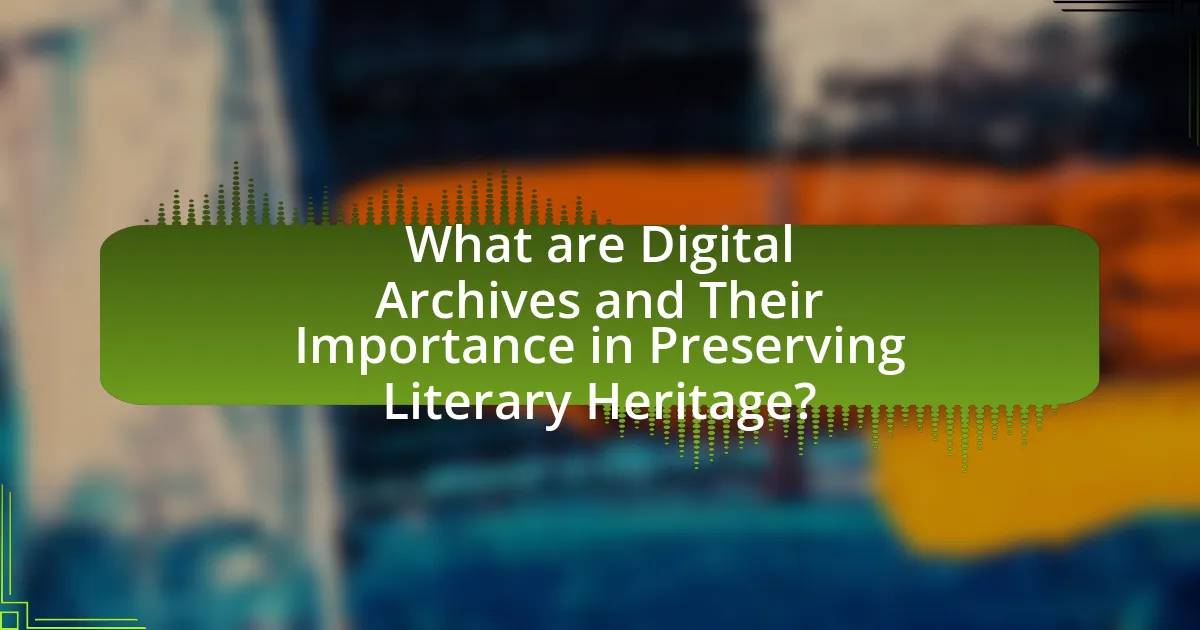
What are Digital Archives and Their Importance in Preserving Literary Heritage?
Digital archives are organized collections of digitized materials that preserve and provide access to literary works, manuscripts, and historical documents. Their importance in preserving literary heritage lies in their ability to safeguard fragile texts from deterioration, facilitate wider access to diverse literary resources, and ensure the longevity of cultural narratives. For instance, the Internet Archive has digitized millions of books, making them accessible globally, which exemplifies how digital archives can democratize access to literary heritage and support research and education.
How have digital archives transformed the way we access literary works?
Digital archives have significantly transformed access to literary works by providing immediate, global availability of texts that were previously limited to physical locations. This transformation is evidenced by the digitization of vast collections, such as the Google Books project, which has made millions of books searchable and accessible online, thereby democratizing access to literature. Additionally, platforms like Project Gutenberg offer free access to over 60,000 public domain texts, allowing users to read and download classic literary works without geographical or financial barriers. This shift not only enhances accessibility but also facilitates research and education by enabling users to easily locate, reference, and analyze a wide array of literary materials.
What technologies enable the creation of digital archives?
Technologies that enable the creation of digital archives include digitization tools, metadata standards, content management systems, and cloud storage solutions. Digitization tools, such as scanners and cameras, convert physical documents into digital formats, allowing for preservation and access. Metadata standards, like Dublin Core and MARC, provide structured information about the digital content, facilitating organization and retrieval. Content management systems, such as Omeka and DSpace, enable the storage, management, and presentation of digital collections. Cloud storage solutions, including Amazon S3 and Google Cloud, offer scalable and secure environments for hosting digital archives, ensuring accessibility and durability. These technologies collectively support the effective creation and maintenance of digital archives, preserving literary heritage online.
How do digital archives enhance accessibility for diverse audiences?
Digital archives enhance accessibility for diverse audiences by providing online access to a wide range of materials that were previously limited to physical locations. This shift allows individuals from various geographical, economic, and social backgrounds to engage with historical documents, literature, and cultural artifacts without the barriers of travel or cost. For instance, the Digital Public Library of America offers millions of photographs, manuscripts, and books that can be accessed freely, thus democratizing information and fostering inclusivity. Additionally, digital archives often include features such as search functionalities, multilingual support, and adaptive technologies, which cater to users with different needs, including those with disabilities. These enhancements ensure that a broader audience can discover, learn from, and contribute to the preservation of literary heritage.
Why is preserving literary heritage crucial in the digital age?
Preserving literary heritage is crucial in the digital age because it ensures the accessibility and continuity of cultural narratives and knowledge. Digital archives facilitate the preservation of texts that might otherwise be lost due to physical degradation or obsolescence of formats. For instance, the Library of Congress has digitized millions of items, making them available to a global audience, which enhances educational opportunities and cultural understanding. Furthermore, preserving literary works in digital formats allows for the integration of advanced search capabilities and interactive features, thereby enriching the user experience and fostering engagement with historical texts.
What risks do traditional archives face that digital archives mitigate?
Traditional archives face risks such as physical deterioration, loss due to disasters, and limited accessibility, which digital archives effectively mitigate. Physical deterioration occurs as traditional materials age, leading to irreversible damage, while digital formats can be preserved indefinitely with proper management. Additionally, traditional archives are vulnerable to disasters like fires or floods, which can result in total loss, whereas digital archives can be backed up in multiple locations, ensuring data recovery. Furthermore, traditional archives often have restricted access due to geographical limitations, while digital archives provide global access, allowing wider dissemination of literary heritage.
How do digital archives contribute to cultural preservation?
Digital archives contribute to cultural preservation by providing accessible, long-term storage of cultural artifacts and documents. They enable the digitization of historical texts, images, and audio recordings, ensuring that these materials are preserved against physical degradation and loss. For instance, the Internet Archive has digitized millions of books and documents, making them available to a global audience, which enhances public engagement and education about cultural heritage. Additionally, digital archives facilitate the preservation of endangered languages and traditions by documenting them in a format that can be easily shared and accessed, thus supporting cultural diversity and continuity.

What are the Key Milestones in the Evolution of Digital Archives?
The key milestones in the evolution of digital archives include the establishment of the first digital libraries in the 1990s, the launch of the Internet Archive in 1996, and the development of the Digital Public Library of America in 2013. The 1990s marked a significant shift as institutions began digitizing collections, making them accessible online. The Internet Archive, founded by Brewster Kahle, aimed to provide universal access to all knowledge, preserving web pages and digital content. The Digital Public Library of America further advanced this mission by aggregating digital resources from libraries across the United States, enhancing public access to cultural heritage. These milestones demonstrate the progression from physical to digital preservation, facilitating broader access to literary heritage.
How did the concept of digital archiving begin?
The concept of digital archiving began in the late 20th century with the advent of computers and the internet, enabling the storage and retrieval of information in digital formats. Early initiatives, such as the establishment of the Internet Archive in 1996, aimed to preserve web pages and digital content for future access, marking a significant shift from traditional physical archiving methods. This transition was driven by the need to safeguard cultural and historical materials in an increasingly digital world, as evidenced by projects like the Library of Congress’s digitization efforts, which began in the 1990s to make vast collections accessible online.
What were the first digital archives established, and what did they contain?
The first digital archives established were the NASA’s “Apollo Lunar Surface Journal” in 1994 and the “Project Gutenberg” in 1971. The Apollo Lunar Surface Journal contained detailed documentation of the Apollo missions, including photographs, transcripts, and mission data. Project Gutenberg focused on digitizing and distributing literary works, initially offering over 40,000 eBooks, primarily classic literature and historical texts. These archives laid the groundwork for digital preservation and access to cultural and scientific heritage.
How has the internet influenced the growth of digital archives?
The internet has significantly accelerated the growth of digital archives by providing a global platform for the storage, accessibility, and dissemination of information. This transformation is evidenced by the rapid increase in online repositories, such as the Internet Archive, which has amassed over 600 billion web pages since its inception in 1996. Furthermore, the internet enables institutions and individuals to digitize and share vast collections of texts, images, and multimedia, thereby enhancing preservation efforts and broadening access to literary heritage. The ease of online access has also led to collaborative projects, such as Europeana, which aggregates millions of digitized items from European cultural heritage institutions, demonstrating the internet’s role in fostering international cooperation in archiving.
What advancements have shaped the development of digital archives over time?
Advancements in technology, such as the development of the internet, digitization techniques, and metadata standards, have significantly shaped the evolution of digital archives. The internet has enabled widespread access to digital content, allowing users to retrieve information from anywhere globally. Digitization techniques, including optical character recognition (OCR) and high-resolution imaging, have facilitated the conversion of physical documents into digital formats, preserving them for future generations. Additionally, the establishment of metadata standards, such as Dublin Core and MARC, has improved the organization and retrieval of archived materials, ensuring that users can efficiently locate and access relevant information. These advancements collectively enhance the accessibility, preservation, and usability of digital archives.
How have changes in technology impacted the preservation methods used in digital archives?
Changes in technology have significantly enhanced the preservation methods used in digital archives by introducing advanced storage solutions, improved metadata standards, and automated preservation techniques. For instance, the transition from magnetic tape to cloud storage has increased data durability and accessibility, allowing for scalable and cost-effective solutions. Additionally, the adoption of standardized metadata formats, such as Dublin Core, has facilitated better organization and retrieval of digital assets, ensuring that archived materials remain discoverable over time. Furthermore, automated tools for format migration and integrity checks, such as the use of checksums, have streamlined the preservation process, reducing the risk of data loss and obsolescence. These technological advancements collectively contribute to more efficient and reliable digital archiving practices.
What role do collaborative projects play in the evolution of digital archives?
Collaborative projects significantly enhance the evolution of digital archives by pooling resources, expertise, and diverse perspectives to create more comprehensive and accessible collections. These projects often involve partnerships between libraries, universities, and cultural institutions, which facilitate the digitization of rare texts and artifacts that might otherwise remain inaccessible. For example, the Digital Public Library of America (DPLA) aggregates content from libraries and archives across the United States, providing a unified platform that increases visibility and usability of digital collections. This collaborative approach not only broadens the scope of available materials but also fosters innovation in archival practices, ensuring that literary heritage is preserved and made available to a wider audience.
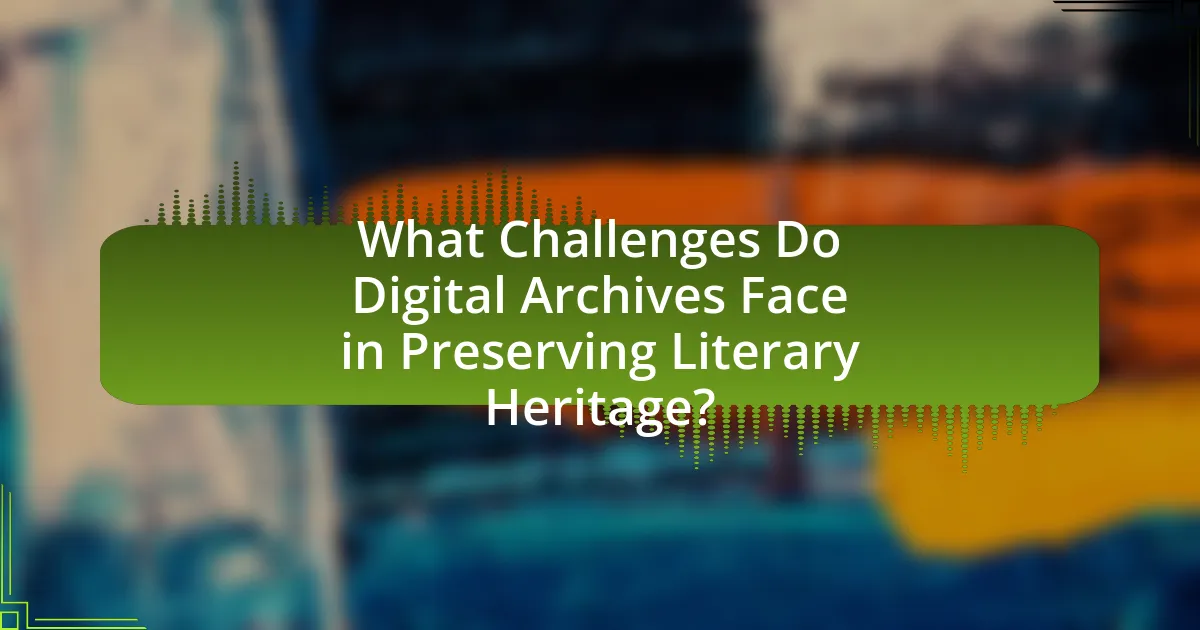
What Challenges Do Digital Archives Face in Preserving Literary Heritage?
Digital archives face significant challenges in preserving literary heritage, primarily due to issues of technological obsolescence, data integrity, and accessibility. Technological obsolescence occurs as software and hardware evolve, potentially rendering archived materials inaccessible if they are not regularly updated or migrated to current formats. Data integrity is threatened by risks such as data corruption, loss, or unauthorized alterations, which can compromise the authenticity of literary works. Accessibility challenges arise from varying levels of digital literacy among users and the digital divide, which can limit access to these archives for certain populations. According to a study by the Digital Preservation Coalition, 70% of organizations reported concerns about the long-term sustainability of their digital collections, highlighting the urgency of addressing these challenges.
What are the technical challenges associated with maintaining digital archives?
The technical challenges associated with maintaining digital archives include data integrity, format obsolescence, and security vulnerabilities. Data integrity is crucial as digital files can become corrupted over time, leading to loss of information. Format obsolescence occurs when file formats become outdated, making it difficult to access or read archived materials; for instance, proprietary formats may no longer be supported by current software. Security vulnerabilities pose risks of unauthorized access or data breaches, which can compromise sensitive information stored in digital archives. These challenges necessitate ongoing efforts in digital preservation strategies to ensure long-term accessibility and reliability of archived content.
How do issues of data storage and format obsolescence affect digital archives?
Issues of data storage and format obsolescence significantly impact digital archives by threatening the accessibility and longevity of stored information. Digital archives rely on specific formats and storage media, which can become outdated as technology evolves. For instance, formats like floppy disks or older video codecs may no longer be supported by modern systems, making it difficult to retrieve or interpret archived data. According to a study by the Library of Congress, approximately 90% of digital formats are at risk of obsolescence within a decade, highlighting the urgency for continuous migration and updating of digital archives to ensure their preservation and accessibility over time.
What security concerns must be addressed to protect digital literary heritage?
To protect digital literary heritage, key security concerns include data integrity, unauthorized access, and digital preservation. Data integrity ensures that digital texts remain unaltered and authentic over time, which is critical for maintaining their historical and cultural value. Unauthorized access poses a risk of theft or alteration of literary works, necessitating robust access controls and encryption methods to safeguard sensitive materials. Digital preservation involves implementing strategies to prevent data loss due to technological obsolescence or cyber threats, highlighting the need for regular backups and migration to current formats. Addressing these concerns is essential for the long-term sustainability and accessibility of digital literary heritage.
How do ethical considerations impact the management of digital archives?
Ethical considerations significantly impact the management of digital archives by guiding decisions on access, preservation, and the representation of materials. These considerations ensure that the rights of creators, subjects, and communities are respected, particularly in relation to copyright, privacy, and cultural sensitivity. For instance, the American Library Association emphasizes the importance of ethical stewardship in digital archiving, advocating for transparency and accountability in how materials are collected and shared. Furthermore, ethical frameworks help archivists navigate complex issues such as the digitization of sensitive materials, ensuring that marginalized voices are represented fairly and accurately. This adherence to ethical standards not only fosters trust among users but also enhances the integrity and sustainability of digital archives.
What are the implications of copyright laws on digital archiving?
Copyright laws significantly impact digital archiving by restricting the reproduction and distribution of copyrighted materials without permission. These laws require archivists to navigate complex legal frameworks to ensure compliance while attempting to preserve and provide access to literary heritage. For instance, the U.S. Copyright Act of 1976 grants authors exclusive rights to their works, which means that digital archives must obtain licenses or rely on fair use provisions to digitize and share content. Failure to adhere to these laws can result in legal repercussions, including lawsuits and financial penalties, thereby complicating the mission of preserving cultural and literary artifacts in a digital format.
How can digital archives ensure equitable access to literary works?
Digital archives can ensure equitable access to literary works by implementing open access policies and utilizing user-friendly technology. Open access policies allow users to freely access and share literary works without financial barriers, promoting inclusivity. For instance, the Public Library of Science (PLOS) has demonstrated that open access increases readership and citations, thereby enhancing the visibility of literary works. Additionally, employing user-friendly technology, such as mobile-friendly interfaces and multilingual support, can cater to diverse audiences, ensuring that individuals from various backgrounds can easily navigate and access these resources. This approach aligns with the principles of equitable access, as evidenced by initiatives like Project Gutenberg, which provides over 60,000 free eBooks to the public, thereby democratizing access to literature.
What Best Practices Should Be Followed for Effective Digital Archiving?
Effective digital archiving requires adherence to several best practices, including the use of standardized formats, regular backups, and metadata creation. Standardized formats, such as PDF/A for documents and TIFF for images, ensure long-term accessibility and compatibility across different systems. Regular backups, ideally following the 3-2-1 rule (three copies of data, two local but on different devices, and one off-site), protect against data loss. Additionally, creating comprehensive metadata enhances discoverability and context, facilitating easier retrieval and understanding of archived materials. These practices are supported by guidelines from organizations like the Digital Preservation Coalition, which emphasizes the importance of these strategies in maintaining the integrity and usability of digital archives.
How can organizations develop a sustainable digital archiving strategy?
Organizations can develop a sustainable digital archiving strategy by implementing a comprehensive framework that includes clear policies, robust technology, and ongoing training. Establishing clear policies ensures that there are guidelines for what materials to archive, how to manage them, and the standards for digital preservation. Utilizing robust technology, such as cloud storage and metadata standards, facilitates efficient storage and retrieval of archived materials. Ongoing training for staff ensures that they are equipped with the necessary skills to manage digital archives effectively. According to the Digital Preservation Coalition, organizations that adopt these practices can enhance the longevity and accessibility of their digital collections, thereby preserving literary heritage for future generations.
What tools and resources are available for creating and managing digital archives?
Tools and resources available for creating and managing digital archives include software applications like Omeka, ArchivesSpace, and DSpace, which facilitate the organization, preservation, and access to digital collections. Omeka is a web-publishing platform specifically designed for sharing digital collections and exhibits, while ArchivesSpace is an open-source archival management system that helps institutions manage their archival holdings. DSpace serves as a digital repository system for managing and sharing scholarly works and research outputs. These tools are widely used in libraries, museums, and educational institutions to ensure the effective preservation of literary heritage in digital formats.
